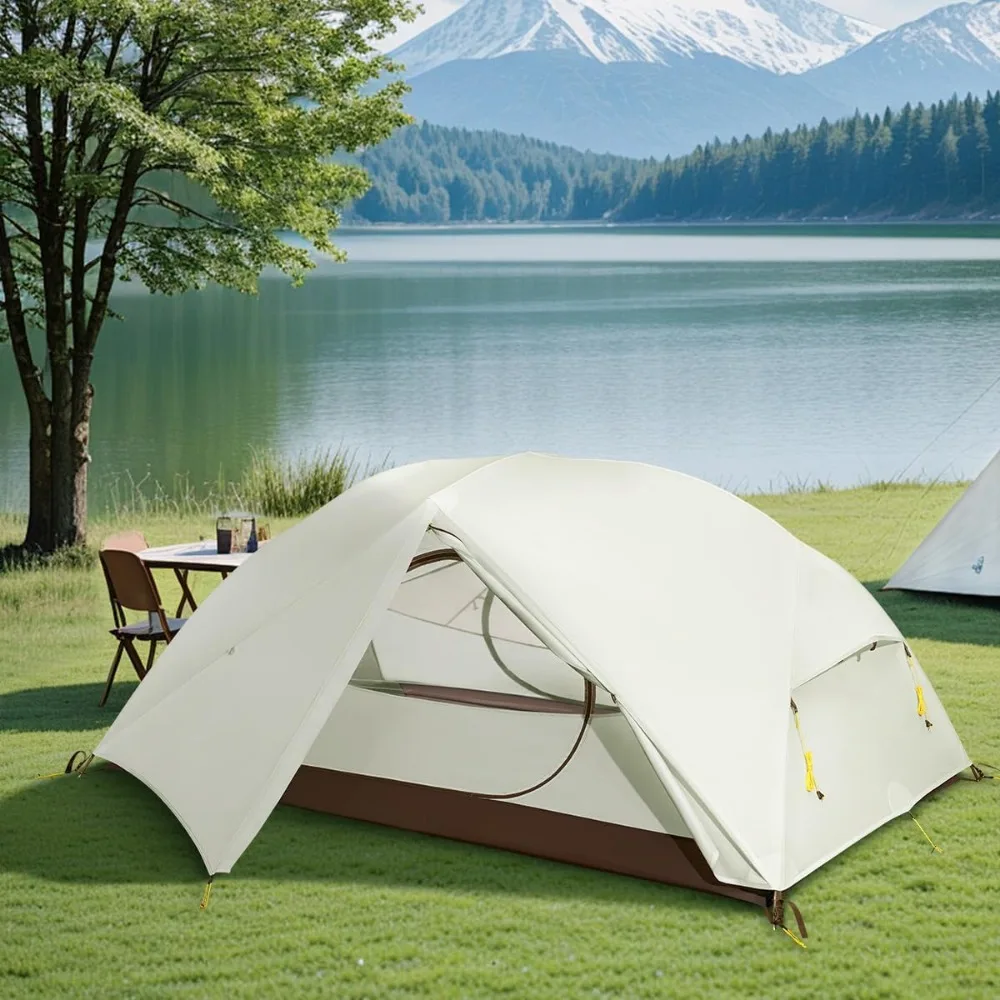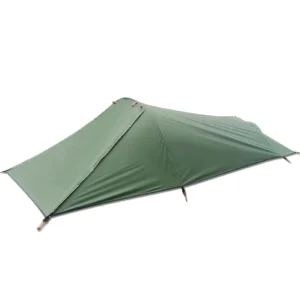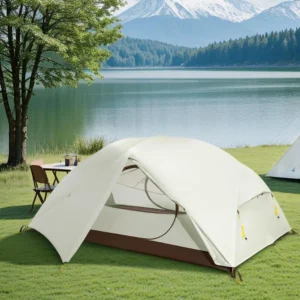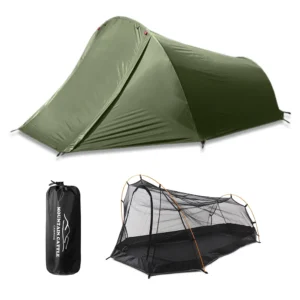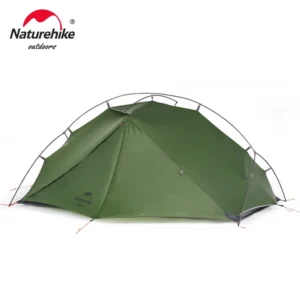Introduction: Why Tent Weight Matters on the Trail
When planning a backpacking trip, every ounce you carry directly impacts your hiking experience. Among all your gear, your tent typically represents one of the heaviest single items, often weighing between 1-4 pounds and making up 15-25% of your total base weight. This significant portion of your pack weight makes tent selection a critical decision that deserves careful consideration.
The fundamental challenge every backpacker faces is finding the right balance between carrying lightweight gear and maintaining adequate comfort, durability, and protection. A tent that’s too heavy can lead to exhaustion and reduced enjoyment of your journey, while one that’s too light might sacrifice necessary features or durability.
There’s no single “perfect” tent weight that works for everyone. The ideal weight depends on your specific needs, trip style, physical condition, expected weather conditions, and personal comfort requirements. What feels lightweight and comfortable for one hiker might feel restrictive or inadequate for another.
Throughout this guide, we’ll explore every aspect of tent weight for backpacking. We’ll clarify confusing terminology, examine how weight affects your hiking experience, break down weight categories, analyze materials and design features that contribute to weight, and provide strategies for finding your perfect balance. By understanding the mastering two-person lightweight tent setup process and exploring ultralight 2-person tents options, you’ll gain the knowledge needed to make an informed decision about this crucial piece of gear.
Understanding Tent Weight Terminology
Before diving deeper into tent weight considerations, it’s essential to understand the terminology manufacturers use when specifying tent weights. These distinctions help you accurately compare different models and know exactly what you’re getting.
Key Weight Specifications
Packaged Weight: This is the total weight of everything that comes in the box when you purchase a tent. It includes the tent body, rainfly, poles, stakes, stuff sacks, guy lines, repair kit, and any other accessories. This number represents the maximum weight you might carry.
Minimum Weight (Trail Weight): This typically includes only the tent body, rainfly, and poles—the essential components needed to set up a functional shelter. It excludes stakes, guy lines, stuff sacks, and other accessories. Many experienced backpackers consider this the most relevant weight for comparison.
Fast & Light/Fly-Footprint Pitch Weight: This represents an ultralight setup option where you use only the rainfly, poles, and a footprint (sometimes sold separately) to create a minimal shelter. This configuration saves significant weight but offers less protection and comfort.
The American Society for Testing and Materials (ASTM F 1934-98) has established standards for how manufacturers should weigh and label backpacking tents, though not all companies strictly follow these guidelines. This can lead to discrepancies between advertised weights and what you actually carry on the trail.
In real-world situations, the difference between packaged weight and minimum weight often ranges from 10-20%. For example, a tent advertised with a 3-pound minimum weight might have a 3.5-pound packaged weight. These differences matter when you’re carefully counting ounces for a long trek.
Understanding these distinctions is crucial when comparing tents and determining if a 2-person tent is actually big enough for your needs, as capacity and weight often have direct relationships.
How Tent Weight Affects Your Backpacking Experience
The weight of your tent impacts your backpacking journey in more ways than you might initially realize, affecting both physical and psychological aspects of your adventure.
Physical Impacts
Research indicates that each additional pound in your backpack requires approximately 5% more energy expenditure on level terrain—and significantly more on inclines. This means a 2-pound difference in tent weight equals roughly the energy cost of carrying an extra day’s worth of food or two liters of water. Over a multi-day journey covering challenging terrain, this additional energy expenditure accumulates, potentially leading to earlier fatigue, reduced daily mileage, and slower recovery.
Psychological Aspects
Beyond the physical burden, tent weight affects your psychological experience. A heavy pack can create a constant sense of burden that diminishes trail enjoyment. Many experienced backpackers report that lightening their shelter system provides one of the most noticeable improvements to their hiking experience, creating a sense of freedom and agility on the trail.
Base Weight Proportion
Your tent typically represents 15-25% of your “base weight” (the weight of your pack without consumables like food, water, and fuel). This significant proportion means that reducing tent weight can have a greater impact on your overall load than many other gear optimizations.
Terrain Considerations
Weight impacts become magnified in challenging terrain. On flat terrain, a heavier tent might cause minimal discomfort, but on steep ascents or technical trails, each extra ounce becomes increasingly noticeable. Similarly, on longer trips, weight savings compound day after day, while on weekend outings, the benefit of ultralight gear may be less significant.
Selecting appropriate compact camping shelters for forest hiking becomes particularly important when navigating through dense woods, where carrying a bulky, heavy tent can be especially cumbersome when moving through tight spaces between trees.
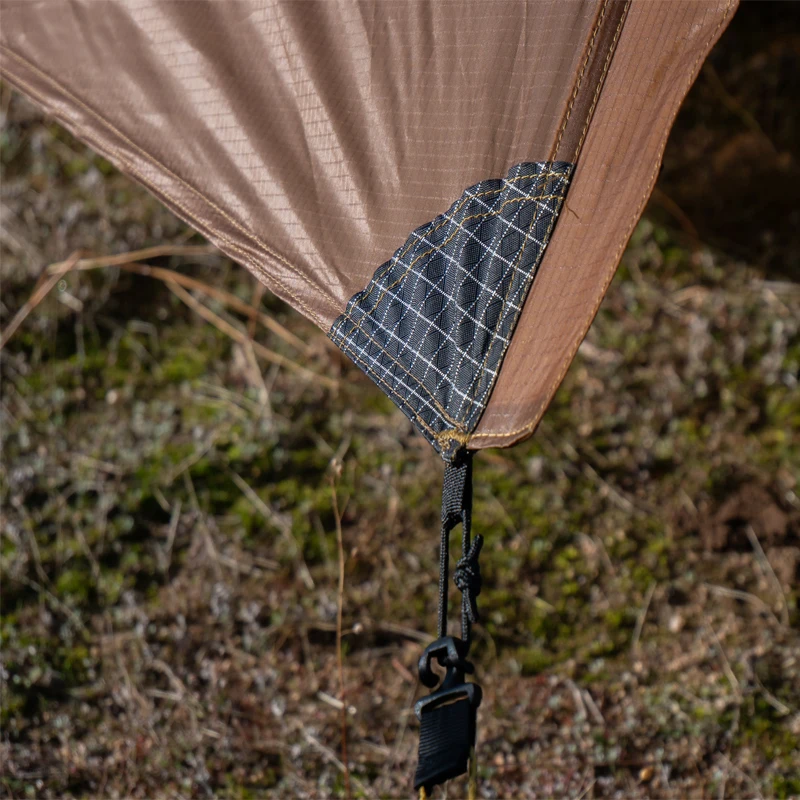
Backpacking Tent Weight Categories: What’s Light, What’s Heavy?
Understanding tent weight categories provides useful benchmarks when evaluating options. While these categories aren’t universally standardized, they offer helpful guidance for both 1-person and 2-person tents.
Heavyweight (over 4.5 lbs/2 kg for 2P)
Characteristics:
– Robust materials with high denier ratings
– Freestanding design with sturdy aluminum poles
– Multiple doors and vestibules
– Generous interior space and headroom
– Numerous features and storage options
Advantages:
– Excellent durability and longevity
– Better weather protection in extreme conditions
– More comfortable living space
– Often more affordable than lighter options
Disadvantages:
– Significant weight penalty
– Larger packed size
– May be overkill for many backpacking scenarios
Best for: Car camping with occasional backpacking, base camping, harsh weather conditions, budget-conscious beginners
Midweight (3.25-4.5 lbs/1.47-2 kg for 2P)
Characteristics:
– Balanced materials (moderate denier fabrics)
– Usually freestanding with quality aluminum poles
– Good interior space with adequate headroom
– Decent feature set with some comfort elements
Advantages:
– Good balance of durability and weight
– Reliable performance in various conditions
– More comfortable than ultralight options
– Reasonable price-to-performance ratio
Disadvantages:
– Still noticeably heavier than lightweight options
– Moderate packed size
Best for: Weekend backpackers, those prioritizing comfort with reasonable weight, mixed-use camping
Lightweight (2-3.25 lbs/0.9-1.47 kg for 2P)
Characteristics:
– Lower denier fabrics with strategic reinforcements
– Streamlined design with minimal excess features
– Optimized aluminum or composite pole structures
– Thoughtful balance of space and weight
Advantages:
– Significantly reduced carrying burden
– Good space-to-weight ratio
– Suitable for longer backpacking trips
– Often feature premium materials and construction
Disadvantages:
– Higher cost than heavier options
– Requires more careful handling
– May compromise some comfort features
Best for: Dedicated backpackers, longer trips, those willing to invest in quality gear
Ultralight (under 2 lbs/0.9 kg for 2P)
Characteristics:
– Minimalist design philosophy
– Very thin fabrics (often under 15D)
– Non-freestanding or semi-freestanding designs
– May use trekking poles for support
– Stripped of non-essential features
Advantages:
– Dramatically reduced pack weight
– Often highly packable
– Enables faster, longer daily mileage
– Appeals to weight-conscious adventurers
Disadvantages:
– Premium price point
– Requires careful site selection and setup
– Less durable fabrics need attentive care
– May sacrifice comfort and living space
Best for: Thru-hikers, ultralight enthusiasts, experienced backpackers
Understanding what size tent is good for 2 people and exploring lightweight backpacking tent options will help you find the right balance between weight and living space for your adventures.
Tent Materials: The Building Blocks of Weight
The materials used in tent construction directly determine both weight and performance characteristics. Understanding these components helps you evaluate why tents weigh what they do and make informed decisions about acceptable trade-offs.
Fabric Components
Denier Ratings: Fabric thickness is measured in “denier” (D), with lower numbers indicating thinner, lighter fabrics. Modern backpacking tents typically use:
– Ultralight: 7-15D (extremely light but requires careful handling)
– Lightweight: 15-30D (good balance of weight and durability)
– Standard: 30-70D (more durable with weight penalty)
– Heavy-duty: 70D+ (maximized durability for challenging conditions)
Weight difference is substantial—a tent body made from 10D fabric might weigh half as much as the same design in 40D material.
Common Materials:
– Nylon: Excellent strength-to-weight ratio, but absorbs water
– Polyester: Slightly heavier than nylon but better UV resistance and less stretching when wet
– Silnylon/Silpoly: Nylon or polyester impregnated with silicone, offering excellent waterproofing at lower weight
– Dyneema Composite Fabric (DCF/Cuben Fiber): Ultra-lightweight, waterproof material that doesn’t absorb water; extremely expensive but the gold standard for ultralight tents
Pole Materials and Design
Aluminum: The standard for most backpacking tents, offering good strength-to-weight ratio at reasonable cost. DAC Featherlite poles are common in premium tents.
Carbon Fiber: 20-30% lighter than aluminum with excellent strength but more brittle and significantly more expensive.
Hub Designs: Modern hub systems can reduce weight by creating more interior volume with fewer pole sections, though complex hubs may add some weight themselves.
Pole Configurations: The number of poles and their arrangement significantly impacts weight—minimalist designs using single poles or trekking poles for support achieve the lowest weights.
Smaller Components
While often overlooked, these elements can add up significantly:
Stakes: Weight varies dramatically between types:
– Titanium shepherd’s hooks (0.2-0.3 oz/6-8g each)
– Aluminum Y-stakes (0.4-0.5 oz/11-14g each)
– Heavy-duty aluminum stakes (0.7-1.0 oz/20-28g each)
For a typical tent requiring 8-10 stakes, the difference between ultralight titanium and standard aluminum can be 2-4 ounces (57-113g).
Guylines and Tensioners: Lightweight options like Dyneema cord can save 0.5-1.0 oz (14-28g) over standard cordage.
Zippers and Hardware: Premium lightweight zippers and minimalist pulls can reduce weight by 1-2 oz (28-57g).
The weight implications of these material choices highlight why waterproof backpacking tent options vary so dramatically in their specifications and pricing, as waterproofing methods and materials directly impact total weight.
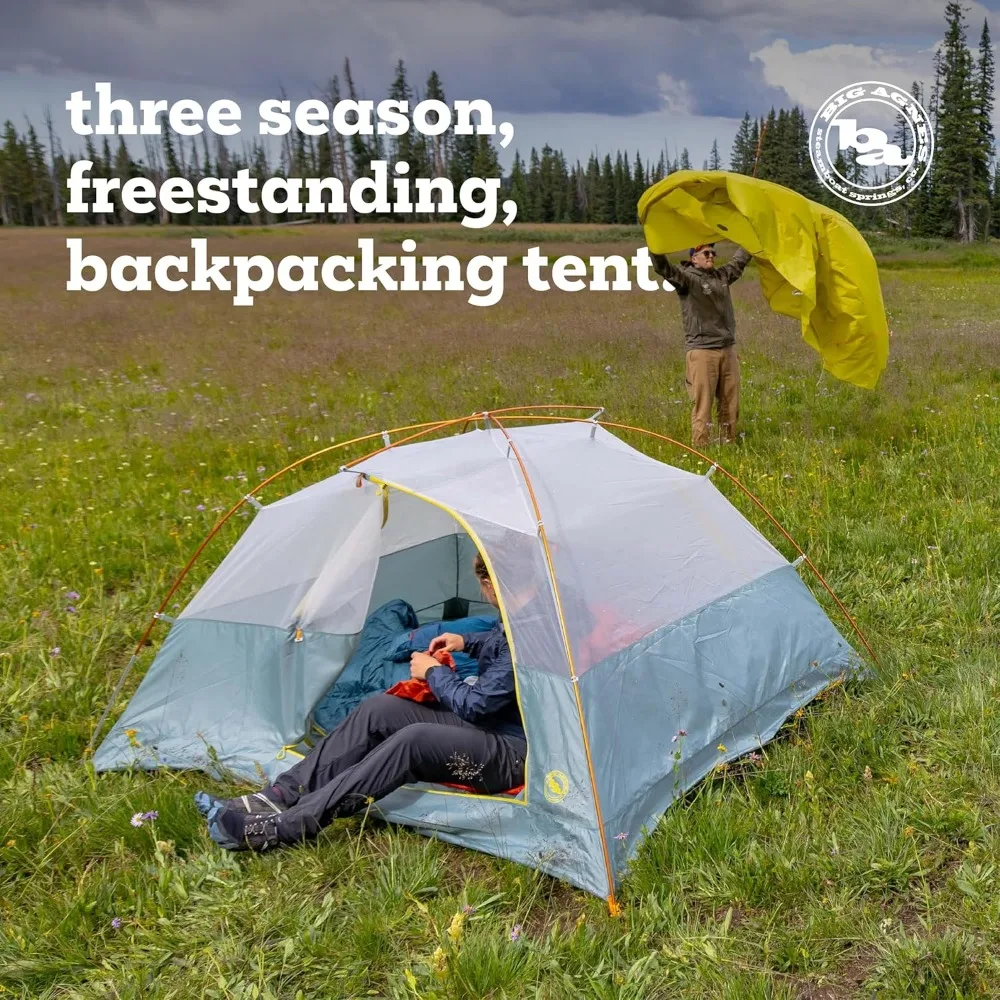
Tent Design Features: Where Every Ounce Counts
Beyond materials, the structural design and features of a tent significantly impact its weight. Understanding these design elements helps you identify which features are worth their weight for your specific needs.
Tent Structure Types
Freestanding vs. Non-freestanding: Freestanding tents can stand without stakes and are easier to set up but typically weigh more due to more extensive pole structures. Non-freestanding tents save weight by requiring stakes or trekking poles for support but demand more setup skill and appropriate terrain.
Single-wall vs. Double-wall Construction:
– Double-wall tents (separate inner tent and rainfly) offer better condensation management and versatility but weigh more
– Single-wall tents combine these layers to save weight but often struggle with condensation and may feel less comfortable in humid conditions
Design Shapes:
– Dome designs offer good strength-to-weight ratios with reasonable headroom
– Tunnel tents maximize interior space for their weight but may require more careful orientation to wind
– Pyramid designs achieve excellent storm resistance with minimal poles but often have sloping walls that reduce usable space
Capacity and Dimensions
Floor Space: The square footage directly impacts weight. A typical 2-person tent offers 28-32 square feet (2.6-3.0 square meters). Each additional square foot adds approximately 0.5-1.0 oz (14-28g) depending on materials.
Interior Volume: Vertical walls and strategic pole placement create more usable space without adding square footage. Some lightweight designs sacrifice headroom and create sloping walls to reduce material and pole weight.
“Sizing Up” Strategy: Some solo hikers choose a 2-person tent for extra space at a weight penalty of 20-40%. This approach provides more comfort and gear storage space while still potentially weighing less than some heavier 1-person options.
Access and Storage Features
Doors: Dual doors add convenience but increase weight by approximately 3-6 oz (85-170g) compared to single-door designs due to additional zippers, fabric, and often a second vestibule.
Vestibules: These protected external storage areas add weight but protect gear from elements. A standard vestibule adds roughly 2-5 oz (57-142g) depending on size and materials.
Interior Storage: Mesh pockets, gear lofts, and other organization features typically add 0.5-2.0 oz (14-57g) to tent weight.
Weather Protection Elements
Guy-out Points: Additional tie-out points strengthen the tent against wind but add weight through extra cordage, reinforcement points, and potentially stakes.
Ventilation Systems: Features like roof vents, adjustable vents, and kickstand rainfly configurations improve airflow and reduce condensation but add incremental weight.
Rainfly Coverage: Full-coverage rainflies provide maximum weather protection but weigh more than partial coverage designs, which may leave end walls or portions of the tent body exposed.
When choosing the ultimate compact shelter for two, these design features must be carefully evaluated. The differences between freestanding backpacking tent designs and ultralight trekking pole tent options illustrate how structure dramatically affects both weight and functionality.
The Seasonality Factor: How Weather Protection Affects Weight
The intended seasonal use of a tent directly influences its weight. Understanding these differences helps you avoid carrying unnecessary weight in mild conditions or finding yourself with inadequate protection in harsh environments.
3-Season Tents (Spring, Summer, Fall)
Characteristics:
– Lighter fabrics (typically 10-30D)
– More mesh for ventilation and lower weight
– Moderate pole structure for stability in typical conditions
– Partial or full rainfly depending on design
– Standard floor waterproofing (1200-2000mm)
Typical Weight Range:
– 1P: 1.0-2.5 lbs (0.45-1.13 kg)
– 2P: 2.0-4.0 lbs (0.9-1.8 kg)
Best For: Most backpacking trips in temperate conditions, mild weather, and protected campsites
Extended Season/3+ Season Tents
Characteristics:
– More durable fabrics (usually 20-40D)
– Less mesh, more solid walls for better insulation
– Stronger pole structures to handle moderate snow loads
– Full-coverage rainfly with fewer or smaller vents
– Higher waterproof ratings (2000-3000mm)
Typical Weight Range:
– 1P: 1.5-3.0 lbs (0.7-1.36 kg)
– 2P: 3.0-4.5 lbs (1.36-2.04 kg)
Weight Increase: Typically 20-30% heavier than comparable 3-season models
Best For: Early spring, late fall, mild winter conditions, higher elevations, exposed campsites
4-Season/Mountaineering Tents
Characteristics:
– Heavy-duty fabrics (40D+)
– Minimal mesh, emphasis on retaining warmth
– Robust pole structure designed for snow loading and high winds
– Full-coverage rainfly, often extending to ground
– Reinforced guy-out points and extra stakes
– Highest waterproof ratings (3000mm+)
Typical Weight Range:
– 1P: 3.0-5.0 lbs (1.36-2.27 kg)
– 2P: 4.5-8.0 lbs (2.04-3.63 kg)
Weight Increase: Often 30-50% heavier than comparable 3-season models
Best For: Winter conditions, high-altitude expeditions, extreme weather exposure
Regional and Climate Considerations
Different environments call for specialized weather protection that affects weight:
Humid Environments: Require excellent ventilation and condensation management, often benefiting from double-wall designs despite their weight penalty
Windy Regions: Need stronger pole structures and more guy-out points, adding weight that’s essential for stability
Variable Conditions: May benefit from adaptable designs with removable components, though these versatile features can add overall weight
When selecting a tent, matching seasonality to your expected conditions prevents carrying unnecessary weight or finding yourself with insufficient protection. For winter adventures, 4-season winter 2-person tents provide the necessary protection at a weight premium that’s justified by their enhanced performance in challenging conditions.
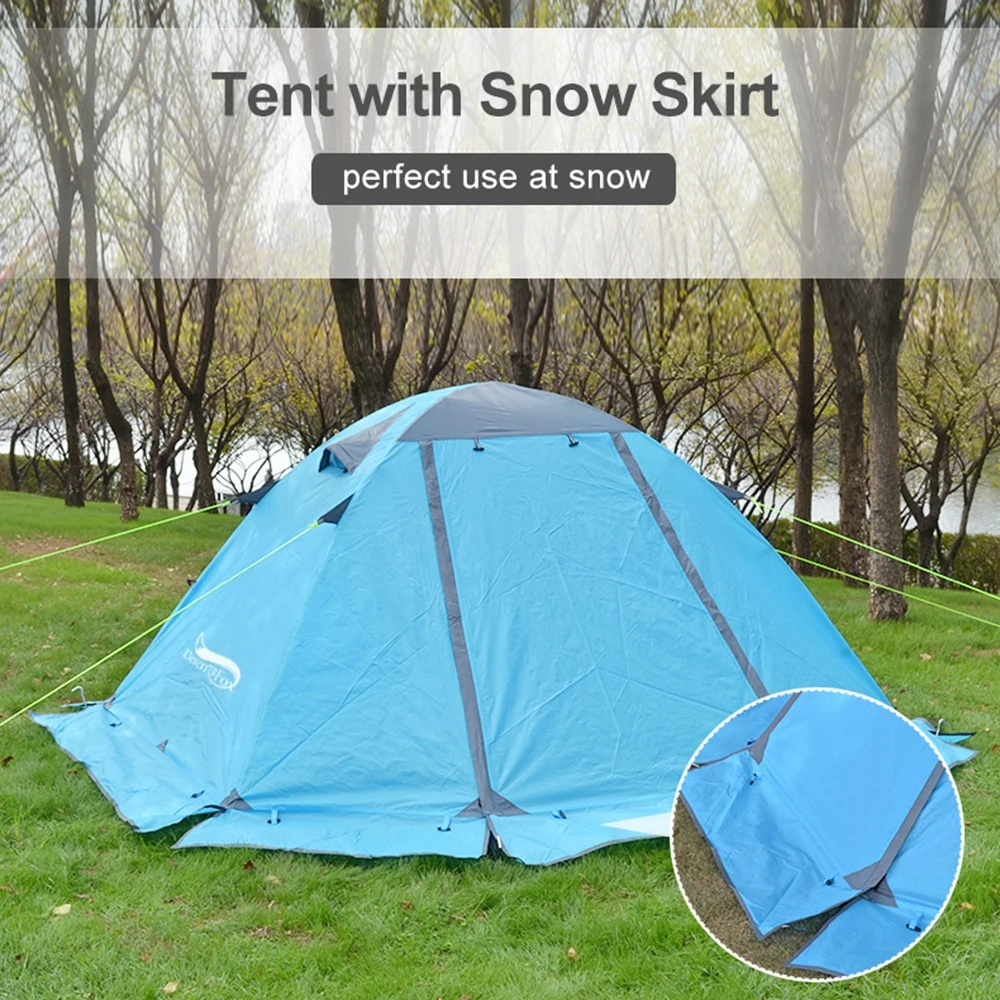
The Essential Trade-offs: Weight vs. Performance
Understanding the key trade-offs between weight and various performance factors helps you make informed decisions about which compromises align with your priorities.
Durability vs. Weight
Lighter tents typically use thinner materials that are more prone to damage:
– Ultralight fabrics (7-15D) may develop tears from minor abrasions
– Lightweight poles may bend or break under stress that heavier poles would withstand
– Reinforcements at stress points are often minimized or eliminated
The durability sacrifice might be acceptable for careful users on well-maintained trails but problematic for rough handling or off-trail adventures. Consider how you treat your gear and your camping environment—rocky, abrasive terrain justifies more durable (and heavier) materials.
Comfort vs. Weight
Weight reduction often comes at the expense of living space and comfort features:
– Reduced floor area (typical ultralight 2P tents offer 25-28 sq ft vs. 30-35 sq ft in heavier models)
– Lower peak height (often 36-38” in ultralight designs vs. 40-45” in standard tents)
– Sloped walls that limit usable space
– Fewer doors, smaller vestibules, and minimal interior storage
These comfort trade-offs become more noticeable on longer trips or during extended weather delays when you spend more time inside your tent.
Weather Protection vs. Weight
Ultralight designs may offer reduced weather performance:
– Less resilience against strong winds
– Fewer guyout points for stabilization
– Thinner floors more prone to puncture and moisture penetration
– Condensation management challenges, especially in single-wall designs
Consider your typical conditions—a superlight tent might be perfect for predictable summer weather but inadequate for shoulder seasons or exposed campsites.
Setup Convenience vs. Weight
Non-freestanding tents save weight but require:
– More time and skill to properly pitch
– Suitable ground for stakes (challenging on rocky terrain, sand, or platforms)
– More adjustments to achieve proper tension
– More care in site selection
This trade-off matters especially when setting up camp in difficult conditions, darkness, or exhaustion.
Long-term Value Considerations
The weight-value equation extends beyond initial purchase:
– Ultralight tents typically cost 30-50% more than comparable midweight options
– Lighter materials may require replacement sooner (2-3 seasons vs. 5+ seasons for heavier tents)
– Repair frequency increases with thinner materials
– Resale value drops faster for worn ultralight gear
For occasional backpackers, the value proposition of ultralight gear diminishes compared to those who use their equipment weekly.
When evaluating these trade-offs, consider that camping shelter options for two vary widely in how they balance these factors. For those undertaking extensive journeys, the ultimate guide to lightweight tents for long treks offers deeper insights into how these trade-offs affect long-distance hikers specifically.
Smart Strategies for Reducing Tent Weight
Whether you’re working with existing gear or shopping for something new, these strategies can help optimize your tent weight without compromising essential protection.
Component Optimization
Stake Swaps: Replace heavy stakes with lightweight alternatives—titanium shepherd’s hooks or carbon fiber stakes can save 1-3 ounces (28-85g) overall.
Lightweight Guylines: Switch standard cordage for premium Dyneema or Spectra cord to save 0.5-1.0 oz (14-28g) while maintaining strength.
Minimize Stuff Sacks: Use a single lightweight stuff sack instead of multiple organizational sacks, or eliminate stuff sacks altogether and pack the tent directly in your backpack to save 0.5-1.5 oz (14-43g).
Selective Packing
Stakes Reduction: Bring only the essential number of stakes needed for your expected conditions rather than the full complement.
Footprint Alternatives: Replace heavy footprints with lightweight window shrink film, Tyvek, or Polycro plastic for savings of 2-6 oz (57-170g).
Weather-Based Decisions: In favorable conditions, consider leaving the rainfly behind for significant weight savings (8-16 oz/227-454g).
Multi-use Gear Strategies
Trekking Pole Shelters: Designs that use your trekking poles for support eliminate dedicated tent poles, saving 8-16 oz (227-454g).
Multi-purpose Items: Use bandanas as stake anchors for sandy soil instead of carrying dedicated sand stakes.
Dual-function Components: Some tent poles can double as trekking poles, reducing overall pack weight.
Load Sharing Between Partners
Split Carrying Duties: Divide tent components between hiking partners (one carries poles and stakes, the other carries canopy and rainfly).
Component Specialization: Each person brings a specialized piece of shelter that combines for a complete system (e.g., one brings tarp, one brings bug net).
Alternative Shelter Options
Tarp Systems: A lightweight tarp (8-12 oz/227-340g) can provide adequate shelter in many conditions at half the weight of a traditional tent.
Bivy Sacks: Minimalist weather protection (8-16 oz/227-454g) works well for those who prioritize weight savings over living space.
Hammock Setups: In forested areas, a hammock with rain protection can offer comfortable shelter that avoids uneven ground while saving weight.
The potential weight savings from these strategies can be substantial—many backpackers have reduced their shelter weight by 1-2 pounds (0.45-0.9 kg) without purchasing new primary gear. However, these approaches often require more skill and accept some reduction in convenience or protection.
For those interested in optimizing their existing setup, mastering tent packing tips provides additional strategies for weight reduction and efficient packing.
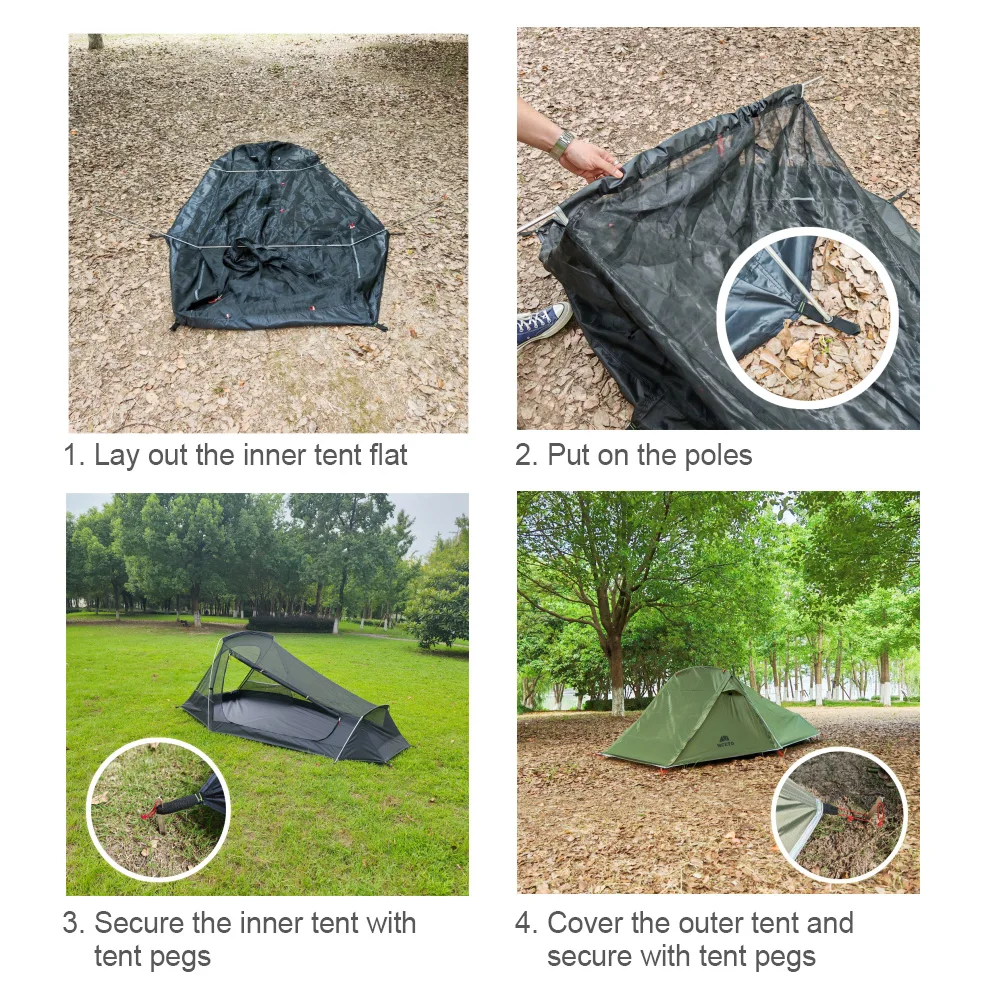
Lightweight Backpacking Tent, Ultralight Backpacking Tent, Ultralight Bivy Tent
Ultralight Single Person Camping Tent with Aluminum Poles for 3-Season Backpacking Waterproof DesignPrice range: $94.88 through $326.82 Select options This product has multiple variants. The options may be chosen on the product pageLightweight Backpacking Tent, Ultralight Backpacking Tent, Waterproof Backpacking Tent
$391.05 Select options This product has multiple variants. The options may be chosen on the product pageHeavy Duty 4 Season Tent, Mountaineering Tent, Winter Camping Tent
$870.40 Select options This product has multiple variants. The options may be chosen on the product pageCompact Backpacking Tent, Lightweight Backpacking Tent, Waterproof Camping Tent
$335.52 Select options This product has multiple variants. The options may be chosen on the product pageUltralight Backpacking Tent, Ultralight Dome Tent, Winter Camping Tent
Price range: $369.63 through $370.07 Select options This product has multiple variants. The options may be chosen on the product pageHeavy Duty 4 Season Tent, Ultralight Freestanding Tent, Winter Camping Tent
$3,722.66 Select options This product has multiple variants. The options may be chosen on the product page
How to Choose the Right Tent Weight for Your Needs
Creating a personalized framework helps you determine the ideal tent weight for your specific needs. Consider these factors systematically to find your perfect balance.
Trip Profile Assessment
Duration:
– Weekend trips (1-3 nights): Weight less critical; comfort features may take priority
– Week-long journeys (4-7 nights): Balance becomes more important
– Extended expeditions (8+ nights): Weight savings compound significantly
Distance:
– Short daily mileage (under 8 miles/13 km): Heavier options more acceptable
– Moderate distances (8-12 miles/13-19 km): Consider midweight options
– Long daily distances (12+ miles/19+ km): Prioritize lightweight or ultralight
Frequency:
– Occasional backpacker (1-5 trips annually): May not justify ultralight investment
– Regular backpacker (6-15 trips annually): Midweight or lightweight likely optimal
– Dedicated backpacker (16+ trips annually): Lightweight or ultralight offers greatest benefit
Environmental Considerations
Weather Expectations:
– Predictable, mild conditions: Supports ultralight choices
– Variable or challenging conditions: Favors more robust options
– Extreme conditions: May require accepting weight penalty for safety
Terrain Factors:
– Established campsites: Accommodate lighter, less durable options
– Backcountry/primitive sites: May require more durable materials
– Alpine/exposed areas: Need wind resistance that often adds weight
Personal Considerations
Physical Capabilities:
– Current fitness level and any physical limitations
– How weight affects your hiking enjoyment and distance capacity
– Recovery speed between hiking days
Comfort Requirements:
– Minimum space needs for sleep comfort
– Tolerance for condensation management
– Desired features (doors, vestibules, headroom)
Experience Level:
– Newer backpackers often benefit from easier setup of freestanding tents
– Experienced users can better utilize specialized lightweight systems
Sample Decision Framework
- Establish your maximum acceptable weight based on physical capabilities and trip profiles
- Determine minimum performance requirements for expected conditions
- List non-negotiable features based on personal preferences
- Identify weight-saving opportunities you’re willing to accept
- Compare options within your established parameters
This personalized approach ensures you find a tent that balances weight with your specific needs rather than simply choosing the lightest or most popular option. When finding your perfect space-saving tent for two, these considerations help navigate the wide range of compact backpacking tent options available.
Beyond the Scale: Other Weight Considerations
While raw weight numbers are important, several related factors affect how tent weight impacts your backpacking experience.
Perceived Weight vs. Actual Weight
How weight feels can differ significantly from what the scale shows. A well-designed 3-pound tent with excellent weight distribution may feel more comfortable to carry than a poorly designed 2.5-pound option. Consider:
- Weight distribution within your pack
- How the tent’s packed size affects pack balance
- Compatibility with your overall packing system
Weight and Sleep Quality Connection
A slight weight penalty that significantly improves sleep quality often justifies itself through improved hiking performance the next day. Research shows that even minor sleep disruptions can reduce physical performance by 10-20% and impair decision-making—factors that directly impact safety and enjoyment.
For many backpackers, an extra 8-16 ounces (227-454g) that provides notably better sleep is weight well spent, as it may improve overall trip experience more than saving those ounces elsewhere.
Evolving Weight Priorities
Many experienced backpackers describe an interesting evolution in their approach to weight:
- Initial Phase: Using conventional, often heavy gear
- Lightweight Pursuit: Becoming weight-conscious and aggressively reducing
- Ultralight Experimentation: Pushing weight limits to absolute minimums
- Balanced Optimization: Finding a personal sweet spot that balances weight with comfort and durability
This evolution reflects growing experience and self-awareness about what truly matters for personal enjoyment rather than following trends or chasing arbitrary weight goals.
Long-term Investment Perspective
Consider tent weight as part of a long-term gear strategy. Sometimes a slightly heavier, more versatile tent that serves multiple purposes (backpacking, car camping, diverse conditions) provides better overall value than an ultralight specialized option with limited use cases.
For many backpackers, having best compact shelters for two that serve diverse conditions may be more practical than owning multiple specialized shelters, even if it means accepting some weight compromise on certain trips.
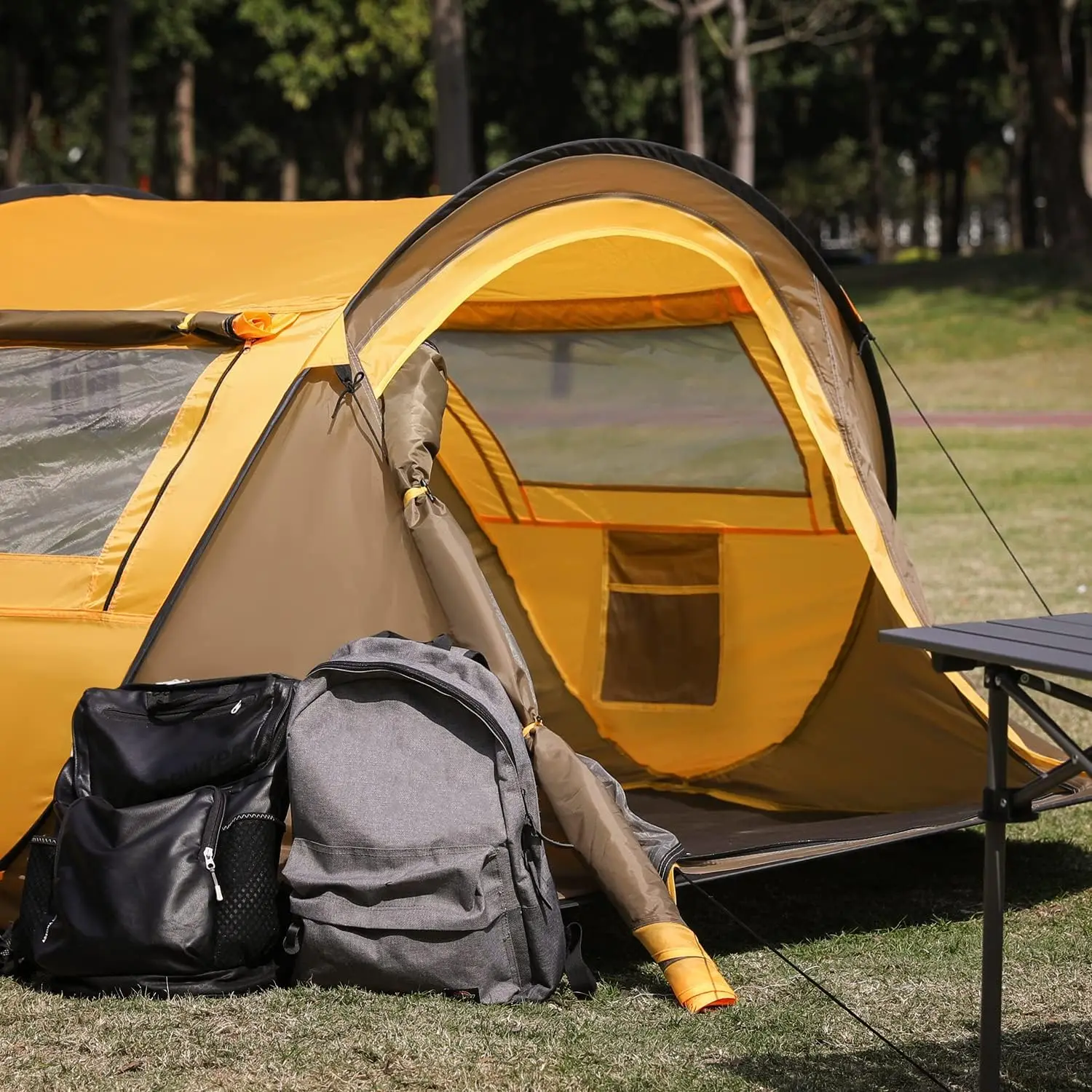
Is Ultralight Always Right? A Balanced Perspective
The ultralight backpacking philosophy has gained tremendous popularity, but it’s worth examining critically rather than accepting it as universally optimal.
Benefits of the Ultralight Approach
- Reduced physical strain and energy expenditure
- Potential for increased daily mileage
- Greater agility and mobility on technical terrain
- Often correlates with simplified systems and minimalist camping
Potential Pitfalls
- Compromised durability in challenging conditions
- Reduced comfort during extended weather events
- Higher financial investment for specialized gear
- Limited versatility across different trip types
- Potentially increased vulnerability to environmental challenges
The “Stupid Light” Concept
Coined by adventure racer Andrew Skurka, “stupid light” refers to taking weight reduction to counterproductive extremes where function, safety, or enjoyment become compromised. Examples include:
- Bringing inadequate rain protection to save weight, resulting in dangerous exposure
- Choosing stakes too lightweight for soil conditions, leading to collapsed shelter
- Eliminating essential repair materials that could have saved a trip
Ultralight as a Spectrum
Rather than viewing ultralight as a binary goal, consider it a spectrum where you make intentional choices about which weight savings benefit your specific needs and which compromises are unacceptable.
Many experienced backpackers find their sweet spot in the “lightweight” rather than “ultralight” category, retaining critical durability and comfort features while still enjoying significant weight benefits over traditional gear.
Context Matters
The appropriateness of ultralight gear depends heavily on:
- Trip duration and remoteness
- Expected environmental conditions
- Available bailout options
- Your experience level and comfort with minimalism
- Personal physical condition and limitations
For someone exploring ultralight backpacking tent options, it’s important to honestly assess whether these designs align with your actual needs rather than simply pursuing the lightest possible solution.
FAQ: Common Questions About Tent Weight
Is it worth spending more for a lighter tent?
For frequent backpackers or those covering significant distances, yes—the investment typically pays dividends in comfort and enjoyment. For occasional backpackers or those primarily doing shorter trips, the cost-benefit ratio may not justify premium ultralight options. Consider how often you’ll use the tent and multiply the weight savings by your expected mileage to evaluate the value proposition.
How much tent weight is too much for long-distance hiking?
For most hikers on multi-day or thru-hikes, keeping tent weight below 2.5 pounds (1.13 kg) per person represents a good target. Solo hikers often aim for under 2 pounds (0.9 kg), while those sharing a tent might accept up to 1.5 pounds (0.68 kg) per person. However, individual physical capabilities and preferences should guide these decisions rather than arbitrary standards.
Can lightweight tents handle severe weather?
Many can, but design matters more than raw weight. A well-designed 2.5-pound tent may outperform a poorly designed 4-pound tent in storms. Look for features like robust pole structures, appropriate guy-out points, and proven designs rather than focusing solely on weight. When severe weather is expected, proper site selection and setup technique often matter more than having the heaviest possible tent.
Should beginners start with lighter or heavier tents?
Beginners typically benefit from moderately weighted, freestanding designs that offer straightforward setup and forgiveness in varied conditions. Midweight options (3-4 pounds/1.36-1.81 kg for a 1P tent) balance ease of use with reasonable carrying comfort. As skills develop and preferences become clearer, moving toward more specialized lightweight options makes sense for those who prioritize weight savings.
How does tent weight impact pack size?
Weight and packed size often correlate but aren’t identical concerns. Ultralight tents typically pack smaller, but materials matter—some lightweight silnylon tents pack larger than slightly heavier options with more compressible fabrics. When space is a primary concern, look specifically at packed dimensions rather than assuming the lightest option will also be the smallest.
Those interested in balancing storage space with weight might find backpacking tent vestibule designs particularly relevant to their needs.
Making Your Final Decision: Questions to Ask Yourself
Before finalizing your tent weight decision, consider these questions to align your choice with your personal needs:
Assess Your Hiking Style
- How would you describe your backpacking approach—focused on covering distance, immersing in nature, or photography and exploration?
- Do you typically hike all day and camp mainly to sleep, or do you enjoy spending time at camp?
- How important is comfort in camp relative to comfort while hiking?
- Are you willing to spend more time finding optimal tent sites to accommodate lighter, more specialized designs?
Evaluate Your Common Trip Scenarios
- What’s the average length of your typical backpacking trips?
- In what seasons do you most frequently backpack?
- What weather conditions do you regularly encounter?
- Do you primarily stick to established trails and campsites, or do you venture off-trail?
- How often do you camp on challenging surfaces (rock, sand, platforms) vs. ideal soil?
Consider Physical Factors
- How does pack weight impact your hiking enjoyment and distance capacity?
- Have you experienced fatigue or discomfort from carrying your current shelter?
- Do you have any physical conditions that make weight more critical?
- How important is ease of setup when you’re tired at day’s end?
Analyze Budget and Long-term Value
- How frequently will you use this tent over its lifetime?
- Is this a long-term investment or a starter tent?
- Would you rather buy one versatile tent or specialized options for different conditions?
- What’s your tolerance for gear maintenance and potential repairs?
Final Decision Checklist
- Does this tent weight allow me to hike comfortably for my typical trip duration?
- Does it provide adequate protection for my expected conditions?
- Does it offer sufficient space and features for my comfort requirements?
- Does the durability match my usage patterns and handling style?
- Does it represent good value for my specific needs and budget?
Remember that the “right” tent weight is highly personal—what works perfectly for someone else might not be ideal for you. By thoughtfully considering these questions, you’ll find the optimal balance for your unique situation among the wide range of 2-person backpacking tents available.
At Explore Elements, we understand that finding the perfect balance between weight and functionality is crucial for enjoying your wilderness adventures. Our carefully selected tents are tested in extreme conditions to ensure they deliver reliable protection without unnecessary bulk, helping you make the most of every backcountry experience.

